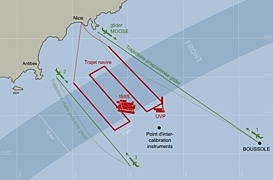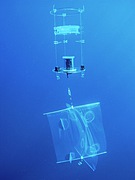Research
Within the partnership, two main research projects will be tackled.
Biophysical interactions at an oceanic front
Fronts are defined as the location where two water masses meet. They are marked by a difference in physical properties of the water, such as temperature or salinity, and the subduction of one water body underneath the other. Those sharp physical changes have considerable influence on biological processes and can act either as barriers or as aggregation points between populations of plankton (Nagano et al 2001). The Ligurian current flows in front of Villefranche’s bay, creating a front between coastal and offshore Mediterranean waters. Its physical characteristics as well as some biological properties (chlorophyll and organic matter concentrations) are monitored by OOV through regular glider (Niewiadomska et al., 2008) and ship-based transects. Despite this intense monitoring, the influence of this front on the distribution of zooplankton communities, jellyfishes and fish larvae in particular, is unknown. The goal of this research project is to build on the information we have on the location and characteristics of the front to target an oceanographic cruise on one of its meanders. By using an array of instruments which combines expertise from the two partners (gliders, ISIIS, UVP, and an oceanographic ship) we will be able to sample continuously, from surface to 200 m depth, a region of 12 km x 15 km with a maximum horizontal resolution of 2km in as little as 10 hours. This sampling effort will be repeated to describe the variability of the frontal structure and its associated biology in time.
 This combination of instruments will provide a precise 3D view of the physical structure of the front as well as the position of each planktonic organism observed (from a few hundred microns to a few centimeters) with a resolution on the order of meters, for both. In addition, this data will be fused with the output from an oceanographic model to interpolate it optimally over the scale of the study area. Such data will allow us to actually 'see' biophysical processes at play, like never before. Using this approach to sample the physics and the biology at the same scale, several precise questions will be asked. How is the distribution of pelagic jellyfishes affected by the front, especially stinging ones (Pelagia noctiluca), which greatly impact human activities (tourism, aquaculture, fisheries) when they reach the shore? Does the front cause an accumulation of larval fish like the front near the Balearic Islands does (Sabatés et al 2007) and how stable are these accumulations? How does the frontal structure influence the downward export of particulate organic matter (marine snow), which plays an essential role for the storage of carbon?
This combination of instruments will provide a precise 3D view of the physical structure of the front as well as the position of each planktonic organism observed (from a few hundred microns to a few centimeters) with a resolution on the order of meters, for both. In addition, this data will be fused with the output from an oceanographic model to interpolate it optimally over the scale of the study area. Such data will allow us to actually 'see' biophysical processes at play, like never before. Using this approach to sample the physics and the biology at the same scale, several precise questions will be asked. How is the distribution of pelagic jellyfishes affected by the front, especially stinging ones (Pelagia noctiluca), which greatly impact human activities (tourism, aquaculture, fisheries) when they reach the shore? Does the front cause an accumulation of larval fish like the front near the Balearic Islands does (Sabatés et al 2007) and how stable are these accumulations? How does the frontal structure influence the downward export of particulate organic matter (marine snow), which plays an essential role for the storage of carbon?
The cruise will be carried on in late spring or early summer, in year 1. The data analysis will follow in the next two years. It will involve Ph.D. students, faculty and permanent technical staff.
- Nagano N, Iwatsuki Y, Okazaki Y, Nakata H (2001) Feeding strategy of japanese sand lance larvae in relation to cili-ated protozoa in the vicinity of a thermohaline front. Journal of Oceanography, 57(2):155-163
- Niewiadomska K, Claustre H, Prieur L, D'Ortenzio F (2008) Submesoscale physical-biogeochemical coupling across the Ligurian current (northwestern Mediterranean) using a bio-optical glider Limnology and Oceanography, 53:2210-2225.
- Sabatés A, Olivar MP, Salat J, Palomera I, Alemany F (2007) Physical and biological processes controlling the distri-bution of fish larvae in the NW Mediterranean Progress In Oceanography, 74(2–3):355-376
What do fish larvae hear in the pelagic environment?
The connections between populations of coastal organisms occur mostly through the exchange of larvae, which spend a few hours to a few months among the plankton. The scale and intensity of this connectivity has important implications for the dynamics, diversity, and management of coastal populations (Cowen et al 2006, 2007).
In fishes, the study of this larval phase has a long history (Hjort 1914), yet we are still struggling to understand and predict connectivity. One factor in particular has only recently revealed its importance: the behavior of the larvae themselves (Irisson et al 2004, Paris and Cowen 2004, Paris et al. 2007, Fiksen et al. 2007). We know now that late-stage larvae of a wide variety of species are able to swim faster than ambient currents, for a long time, and to orient in precise cardinal directions (Leis 2006). But most of this work occurred in the tropical waters of Australia. We need to investigate the generality of those behavioral abilities in Florida and along the Mediterranean coast, to improve our estimates of connectivity there; the depletion of stocks and growing anthropization in both locations makes this data all the more crucial.
To efficiently integrate behavioral data into models of connectivity (Paris et al. 2007), we need to be able to predict the reaction of larvae to the conditions in their physical environment; we need to understand the mechanism behind the behavior. In particular, orientation with respect to sound emanating from the coast was found to be an efficient means for fish larvae, but also corals, to reach their target habitat (Simpson et al 2005). In environments such as the French Riviera and the coastline of Miami, the underwater sound “pollution” by recreational boats and cruise ships could therefore have important consequences.
 We propose to simultaneously sample the "soundscape" and monitor the response of larvae directly in the ocean by using the Drifting In Situ Chamber (DISC), equipped with several environmental sensors. In particular, we will monitor and alter the two components of underwater sound (sound waves which propagate and water particles which move at a microscopic scale) to disambiguate how larvae respond to sound and infer the relevant scales at which sound operates. The DISC is not restricted to the study of larval fish, so these approaches can be generalized (in particular to the case of lobster larvae in Florida, where a research program on these animals is starting).
We propose to simultaneously sample the "soundscape" and monitor the response of larvae directly in the ocean by using the Drifting In Situ Chamber (DISC), equipped with several environmental sensors. In particular, we will monitor and alter the two components of underwater sound (sound waves which propagate and water particles which move at a microscopic scale) to disambiguate how larvae respond to sound and infer the relevant scales at which sound operates. The DISC is not restricted to the study of larval fish, so these approaches can be generalized (in particular to the case of lobster larvae in Florida, where a research program on these animals is starting).
In year 1, the soundscape will be sampled in both locations (in Florida, it will be the continuation of a sampling effort that started in December of 2010). Experiments on the orientation of fish larvae will be carried out the summer of year 2 and data analyzed in year 3. As the previous one, this project will involve Ph.D. students, faculty and permanent technical staff.
- Cowen RK, Paris CB, Srinivasan A (2006) Scaling connectivity in marine populations. Science 311:522-527
- Cowen RK, Gawarkiewicz G, Pineda J, Thorrold SR, Werner FE (2007) Population connectivity in marine systems: An overview. Oceanography, 20(3):14-21
- Fiksen Ø, Jørgensen C, Kristiansen T, Vikebø F, Huse G (2007) Linking behavioural ecology and oceanography : larval behaviour determines growth , mortality and dispersal. Marine Ecology Progress Series, 347:195-205
- Hjort, J (1914) Fluctuations in the great fisheries of northern Europe viewed in the light of biological research. Rapports et Procès-Verbaux des Réunions du Conseil International Permanent pour l'Exploration de la Mer, 20:1-228
- Irisson J-O, LeVan A, De Lara M, Planes S (2004) Strategies and trajectories of coral reef fish larvae optimizing self-recruitment. Journal of Theoretical Biology, 227:205-218.
- Leis, Jeffrey M (2006) Are larvae of demersal fishes plankton or nekton? Advances in Marine Biology, 51:57-141
- Paris CB, Cherubin LM, Cowen RK (2007) Surfing, diving or spinning: effects on population connectivity, Mar Ecol Prog Ser, Theme Section: Advances in modelling physical-biological interactions in fish early life history, 347: 285-300
- Paris CB, Cowen RK (2004) Direct evidence of a biophysical retention mechanism for coral reef fish larvae. Limnology and Oceanography 49(6): 1964-1979
- Simpson SD, Meekan M, Montgomery J, McCauley R, Jeffs A (2005) Homeward sound. Science, 308:221